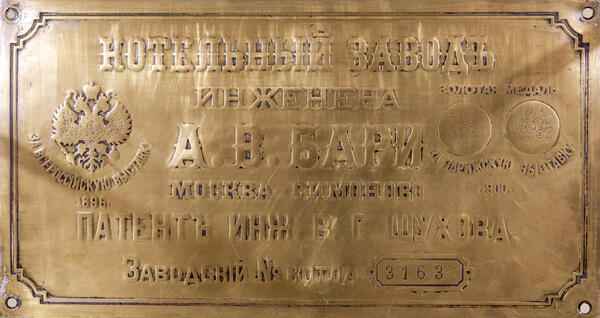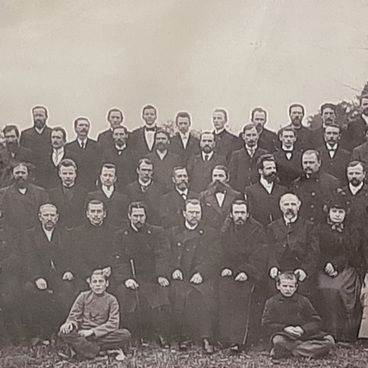Alexander Bari was a prominent Russian engineer, entrepreneur, and social activist, a US citizen. In 1880, Alexander Bari founded the ‘Technical company of engineer A. V. Bari’ and offered his friend and a fellow engineer Vladimir Shukhov the role of chief engineer.
This company has provided technical services ranging from creating projects to physical construction and has soon become famous in the Russian Empire and abroad. Several years later, a prototype of a new boiler for steam locomotives developed by Vladimir Shukhov was manufactured by the company. To launch full scale production of these efficient steam engines, it was decided to construct a production facility that was later named ‘A.V.Bari Boiler Plant.’ The plant was constructed in a famous Moscow suburb, Simonova sloboda, near Simonov Monastery.
The plant was constructed for production of Shukhov’s boilers, metal vessels for oil, and other riveted items. Copper was cast and accessories were processed with machine tools at this facility as well. By February of 1894 the construction of the main facility was complete — a single-story building with stone walls and a metal roof, comprising two round pavilions, each 21 sazhen (147 ft) in diameter, cojoined by the middle pavilion. Net ceiling over the round pavilions of the single-story plant was engineered by Vladimir Shukhov.
The plant was powered by a steam engine with two Shukhov-designed boilers supplying the steam. Heating was provided by burning oil refuse supplied by the nearby warehouses of the Eastern Society.
In just five years after its foundation, Bari’s company owned its own plant near Moscow and had local branches in St. Petersburg, Kharkov, Nizhniy Novgorod, and Ekaterinburg. A.V. Bari Boiler Plant was remembered by its contemporaries not just as a forerunner of the machine construction industry, but as a business with special conditions created by Bari, the capitalist: the plant offered higher wages and shorter work days than its competition, with delicious meals provided by the employer.
The plant had its own hospital with a physician always on duty, offering free medical exams twice a week. Schools were accepting the workers' children and the workers themselves, multi-level social support was provided to the workers and their families.
Bari’s company took part in organizing the World Arts and Industry Expo of 1896 that took place in Nizhniy Novgorod, with several of its pavilions being present at the event. One of the items displayed at the expo was the steam boiler engineered by Vladimir Shukhov. The Expo in Nizhniy Novgorod has secured the status of an imperial court supplier for the “Construction company of engineer A.V. Bari” The same company has contributed to the renovation of water pipe system in Mytishchi and construction of Mytishchi Railcar-Building Plant. Originality and innovation of Bari’s approach to manufacturing have elevated his business above the contemporary competition.
This company has provided technical services ranging from creating projects to physical construction and has soon become famous in the Russian Empire and abroad. Several years later, a prototype of a new boiler for steam locomotives developed by Vladimir Shukhov was manufactured by the company. To launch full scale production of these efficient steam engines, it was decided to construct a production facility that was later named ‘A.V.Bari Boiler Plant.’ The plant was constructed in a famous Moscow suburb, Simonova sloboda, near Simonov Monastery.
The plant was constructed for production of Shukhov’s boilers, metal vessels for oil, and other riveted items. Copper was cast and accessories were processed with machine tools at this facility as well. By February of 1894 the construction of the main facility was complete — a single-story building with stone walls and a metal roof, comprising two round pavilions, each 21 sazhen (147 ft) in diameter, cojoined by the middle pavilion. Net ceiling over the round pavilions of the single-story plant was engineered by Vladimir Shukhov.
The plant was powered by a steam engine with two Shukhov-designed boilers supplying the steam. Heating was provided by burning oil refuse supplied by the nearby warehouses of the Eastern Society.
In just five years after its foundation, Bari’s company owned its own plant near Moscow and had local branches in St. Petersburg, Kharkov, Nizhniy Novgorod, and Ekaterinburg. A.V. Bari Boiler Plant was remembered by its contemporaries not just as a forerunner of the machine construction industry, but as a business with special conditions created by Bari, the capitalist: the plant offered higher wages and shorter work days than its competition, with delicious meals provided by the employer.
The plant had its own hospital with a physician always on duty, offering free medical exams twice a week. Schools were accepting the workers' children and the workers themselves, multi-level social support was provided to the workers and their families.
Bari’s company took part in organizing the World Arts and Industry Expo of 1896 that took place in Nizhniy Novgorod, with several of its pavilions being present at the event. One of the items displayed at the expo was the steam boiler engineered by Vladimir Shukhov. The Expo in Nizhniy Novgorod has secured the status of an imperial court supplier for the “Construction company of engineer A.V. Bari” The same company has contributed to the renovation of water pipe system in Mytishchi and construction of Mytishchi Railcar-Building Plant. Originality and innovation of Bari’s approach to manufacturing have elevated his business above the contemporary competition.



